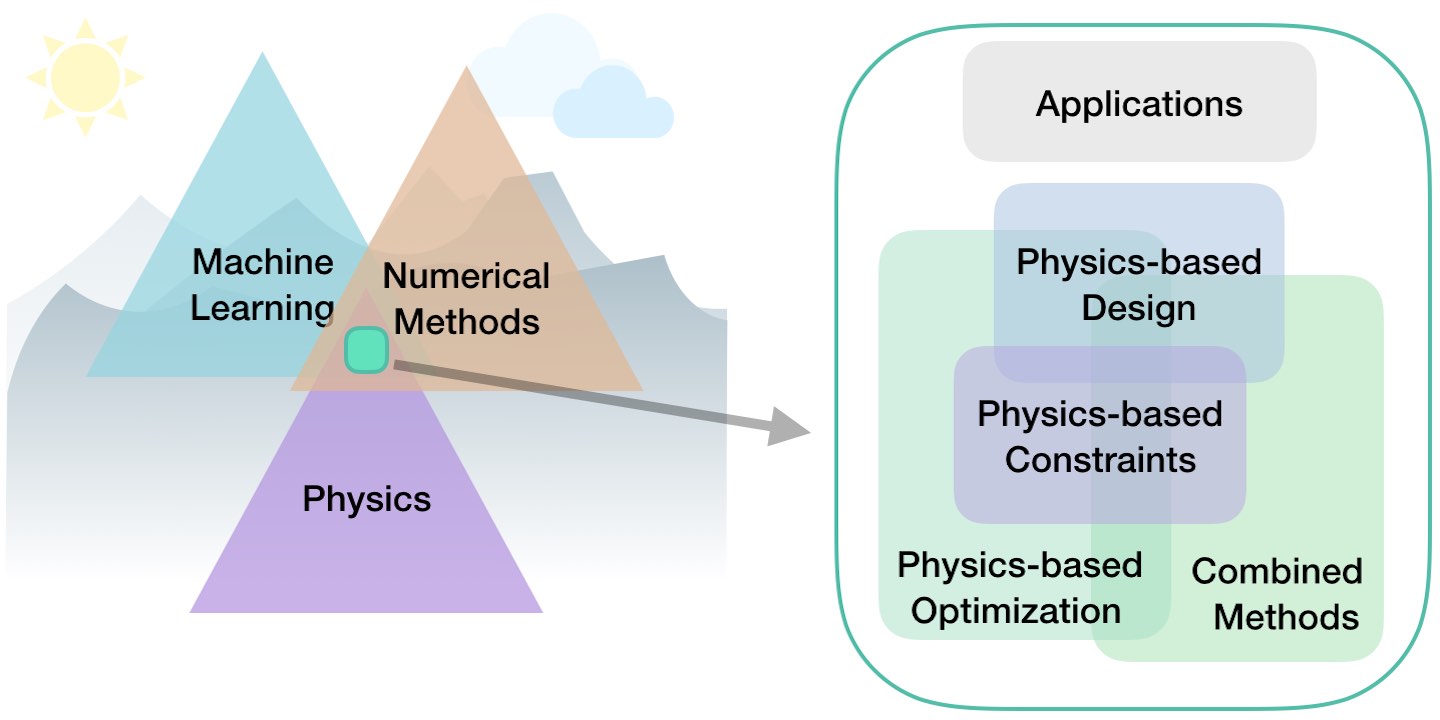The following collection of materials targets "Physics-Based Deep Learning" (PBDL), i.e. the field of methods with combinations of physical modeling and deep learning (DL) techniques. Here, DL will typically refer to methods based on artificial neural networks. The general direction of PBDL represents a very active and quickly growing field of research.
Within this area we can roughly distinguish the following five categories:
-
Physics-based design: incorporate domain knowledge about the system in the architecture of the learning process, e.g., adapt the connectivity of a neural network such that it facilitates certain solutions.
-
Physics-based constraints: guide and constrain the learning process with physical models, e.g., in the simplest case by including additional terms in the loss function.
-
Combined methods: hybrid solvers that employ traditional numerical methods alongside deep-learning techniques to arrive at simulations methods that are improved in terms of, e.g., efficiency, accuracy, generalization etc.
-
Outer-loop optimizations: approaches that aim for higher level control or inverse problems, typically with an outer loop around a simulation. Here, fast and differentiable models exhibit particular promise.
-
Applications: there are also many methods that apply established DL techniques to physical problems without really changing them. These works are nonetheless often highly interesting and much needed to establish methodologies of how DL can be best used for physical problems.
In practice, these categories only serve as a rough guide to the space of methods in the area of physics-based deep learning, and there are many works below that combine aspects from more than one of these classes.
This repository collects links to works on deep learning algorithms for physics problems, with a particular emphasis on fluid flow, i.e., Navier-Stokes related problems. It especially collects links to the works of the I15 lab at TUM, as well as miscellaneous works from other groups. This is by no means a complete list, so let us know if you come across additional papers in this area. We intentionally also focus on works from the deep learning field, not machine learning in general.
tempoGAN: A Temporally Coherent, Volumetric GAN for Super-resolution Fluid Flow , Project+Code: https://ge.in.tum.de/publications/tempogan/
Deep Fluids: A Generative Network for Parameterized Fluid Simulations , Project+Code: http://www.byungsoo.me/project/deep-fluids/
Latent-space Physics: Towards Learning the Temporal Evolution of Fluid Flow , Project+Code: https://ge.in.tum.de/publications/latent-space-physics/
A Multi-Pass GAN for Fluid Flow Super-Resolution , PDF: https://ge.in.tum.de/publications/2019-multi-pass-gan/
A Study of Deep Learning Methods for Reynolds-Averaged Navier-Stokes Simulations , Project+Code: https://github.com/thunil/Deep-Flow-Prediction
Data-Driven Synthesis of Smoke Flows with CNN-based Feature Descriptors , Project+Code: http://ge.in.tum.de/publications/2017-sig-chu/
Liquid Splash Modeling with Neural Networks , Project+Code: https://ge.in.tum.de/publications/2018-mlflip-um/
Generating Liquid Simulations with Deformation-aware Neural Networks , Project+Code: https://ge.in.tum.de/publications/2017-prantl-defonn/
Deep Neural Networks for Data-Driven Turbulence Models , PDF: https://export.arxiv.org/pdf/1806.04482
Deep Dynamical Modeling and Control of Unsteady Fluid Flows , PDF: http://papers.nips.cc/paper/8138-deep-dynamical-modeling-and-control-of-unsteady-fluid-flows
Learning Particle Dynamics for Manipulating Rigid Bodies, Deformable Objects, and Fluids , Project+Code: http://dpi.csail.mit.edu
Reasoning About Liquids via Closed-Loop Simulation , PDF: https://arxiv.org/pdf/1703.01656
Application of Convolutional Neural Network to Predict Airfoil Lift Coefficient , PDF: https://arxiv.org/pdf/1712.10082
Lat-Net: Compressing Lattice Boltzmann Flow Simulations using Deep Neural Networks , PDF: https://arxiv.org/pdf/1705.09036
Prediction of laminar vortex shedding over a cylinder using deep learning , PDF: https://arxiv.org/pdf/1712.07854
Prediction model of velocity field around circular cylinder over various Reynolds numbers by fusion convolutional neural networks based on pressure on the cylinder , PDF: https://doi.org/10.1063/1.5024595
Accelerating Eulerian Fluid Simulation With Convolutional Networks , Project+Code: https://cims.nyu.edu/~schlacht/CNNFluids.htm
IDENT: Identifying Differential Equations with Numerical Time evolution , PDF: https://arxiv.org/pdf/1904.03538.pdf
Data-driven discretization: a method for systematic coarse graining of partial differential equations , PDF: https://arxiv.org/pdf/1808.04930
PDE-Net 2.0: Learning PDEs from Data with A Numeric-Symbolic Hybrid Deep Network , PDF: https://arxiv.org/pdf/1812.04426
Deep Learning the Physics of Transport Phenomena , PDF: https://arxiv.org/pdf/1709.02432
Hidden Physics Models: Machine Learning of Nonlinear Partial Differential Equations , PDF: https://arxiv.org/pdf/1708.00588
Data-assisted reduced-order modeling of extreme events in complex dynamical systems , Project+Code: https://github.com/zhong1wan/data-assisted
PDE-Net: Learning PDEs from Data , Project+Code: https://github.com/ZichaoLong/PDE-Net
Learning Deep Neural Network Representations for Koopman Operators of Nonlinear Dynamical Systems , PDF: https://arxiv.org/pdf/1708.06850
Latent-space Dynamics for Reduced Deformable Simulation , Project+Code: http://www.dgp.toronto.edu/projects/latent-space-dynamics/
Learning-Based Animation of Clothing for Virtual Try-On , PDF: http://www.gmrv.es/Publications/2019/SOC19/
Deep Lagrangian Networks: Using Physics as Model Prior for Deep Learning , PDF: https://openreview.net/pdf?id=BklHpjCqKm
Flexible Neural Representation for Physics Prediction , Project+Code: https://neuroailab.github.io/physics/
Robust Reference Frame Extraction from Unsteady 2D Vector Fields with Convolutional Neural Networks , PDF: https://arxiv.org/pdf/1903.10255.pdf
Physics-as-Inverse-Graphics: Joint Unsupervised Learning of Objects and Physics from Video , PDF: https://arxiv.org/pdf/1905.11169.pdf
Unsupervised Intuitive Physics from Past Experiences , PDF: https://arxiv.org/pdf/1905.10793.pdf
Reasoning About Physical Interactions with Object-Oriented Prediction and Planning , PDF: https://arxiv.org/pdf/1812.10972.pdf
Neural Material: Learning Elastic Constitutive Material and Damping Models from Sparse Data , PDF: https://arxiv.org/pdf/1808.04931
Discovering physical concepts with neural networks , PDF: https://arxiv.org/pdf/1807.10300.pdf
Fluid directed rigid body control using deep reinforcement learning , Project: http://gamma.cs.unc.edu/DRL_FluidRigid/
DeepMimic, Example-Guided Deep Reinforcement Learning of Physics-Based Character Skills , PDF: https://arxiv.org/pdf/1804.02717.pdf
Unsupervised Intuitive Physics from Visual Observations , PDF: https://arxiv.org/pdf/1805.05086
Graph networks as learnable physics engines for inference and control , PDF: https://arxiv.org/pdf/1806.01242.pdf
DeepWarp: DNN-based Nonlinear Deformation , PDF: https://arxiv.org/pdf/1803.09109
Interaction Networks for Learning about Objects, Relations and Physics , PDF: https://arxiv.org/pdf/1612.00222.pdf
A review on Deep Reinforcement Learning for Fluid Mechanics , PDF: https://arxiv.org/pdf/1908.04127.pdf
Machine Learning for Fluid Mechanics , PDF: https://arxiv.org/pdf/1905.11075.pdf
Physics-based deep learning is a very dynamic field. Please let us know if we've overlooked papers that you think should be included by sending a mail to i15ge at cs.tum.de.
Also feel free to check out our homepage at https://ge.in.tum.de/, and our open source fluid simulation and deep learning framework mantaflow: http://mantaflow.com

